
This is a list of the National Register of Historic Places listings in Limestone County, Alabama.

This is a list of the National Register of Historic Places listings in Talladega County, Alabama.

The Bray-Barron House is a historic house in Eufaula, Alabama, U.S.. It was built prior to 1850 for Nathan Bray, who went on to serve in the Confederate States Army during the American Civil War of 1861-1865 alongside his three brothers. The house remained in the family until 1963. It was purchased by N. G. Barron and his wife Ruby Hutton Barron in 1965. It has been listed on the National Register of Historic Places since May 27, 1971.

The Drewry-Mitchell-Moorer House is a historic mansion in Eufaula, Alabama, U.S.. It was built for Dr. John Drewry in 1867. It remained in the family until the 1970s, having been inherited by Drewry's daughter, Lilly Mitchell, followed by her son, A. C. Mitchell, and his daughter, Mrs. W. D. Moorer. It has been listed on the National Register of Historic Places since April 13, 1972.
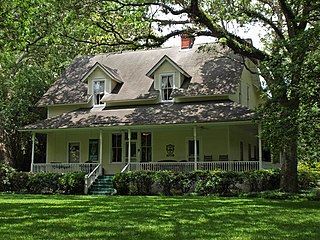
The Sunnyside Hotel is a historic house in Magnolia Springs, Alabama, U.S.. It was built in 1897 for Christopher McLennan. It was converted into a hotel by the new owner, Mrs William Harding, in 1913. In the 1940s, it was inherited by her sister and brother-in-law, who used it as a private home until the 1980s, when they sold it to new owners. In 1996, it was sold to David Worthington. It has been listed on the National Register of Historic Places since February 20, 1998.

The Dr. C.A. Thigpen House is a historic mansion in Montgomery, Alabama, U.S.. It was built for Dr. Charles A. Thigpen, a physician, circa 1898. It was designed in the classical style by architect Frank Lockwood. It has been listed on the National Register of Historic Places since 13 December 1977.
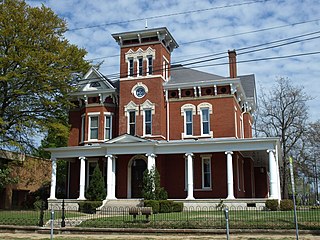
The Tyson–Maner House is a historic mansion in Montgomery, Alabama, U.S.. It was built in 1890 for Archibald Pitt Tyson, a former farmer turned real estate developer. It remained in the family until 1930, as it was inherited by his wife Ellen Nicholson Arrington in 1918 and later by their children. By the 1970s, it belonged to Carl Herbert Lancaster, an architect. It has been listed on the National Register of Historic Places since May 10, 1979.

The Steiner–Lobman and Teague Hardware Buildings are historic buildings in Montgomery, Alabama, U.S.. They were built by businessmen Louis Steiner and Nathan Lobman circa 1891 for their dry goods store. By 1895, the Southern building was sold to William Martin Teague, the owner of the Teague Hardware Company. The buildings remained in the respective families as late as the 1970s. They have been listed on the National Register of Historic Places since January 31, 1979.

The Rice-Semple-Haardt House is a historic house in Montgomery, Alabama, U.S..

The Pepperman House is a historic house located at 17 Mildred Street in Montgomery, Alabama.

The Bass-Perry House is a historic plantation house in Seale, Alabama, U.S.
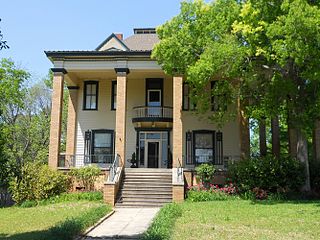
The Floyd-Newsome House is a historic house in Phenix City, Alabama, U.S.. It was built in 1898 as a cottage for Dr Floyd, a physician and judge who was also the mayor of Phenix City. By 1908, a second story was built, and it was redesigned in the classical architectural style. It remained in the Floyd family until 1958, when it was purchased by the Aldridge family. It has been listed on the National Register of Historic Places since November 3, 1983.

The Samuel R. Pitts Plantation, also known as the Greenwood Plantation or the William J. Benton House, is a historic house on a plantation in Pittsview, Alabama, U.S..

The Miller-Martin Town House is a historic house in Clayton, Alabama, U.S.. It was built as a townhouse for John H. Miller in 1859, and it was designed in the Gothic Revival architectural style. In 1871, it was purchased by Judge Henry Clinton Russell, who served on Barbour County's probate court. In 1915, it was purchased by John Council Martin, who went on to serve as the mayor of Clayton from 1926 to 1930. It was later inherited by his daughter. It has been listed on the National Register of Historic Places since December 16, 1974.

Sheppard Cottage is a historic house in Eufaula, Alabama, U.S.. It was built for Henry H. Field in 1837. It was later purchased by Mariah A. Snipes, who lived in the house until she deeded it to John DeWitt Snipes in 1858. In 1868, it was acquired Dr. Edmund Sheppard, a physician and a veteran of the Confederate States Army during the American Civil War of 1861–1865. It was later purchased by C. L. Lunsford, who eventually gave it to the Eufaula Heritage Association. It has been listed on the National Register of Historic Places since May 27, 1971.

The Joel Hurt House is a historic house in Hurtsboro, Alabama, U.S.. It was built in 1857-1858 for Joel Hurt, his wife, Lucy Apperson Long Hurt, and three sons. During the American Civil War of 1861–1865, the three sons served in the Confederate States Army, and one of them was killed in combat. After the war, Lucy's sister and her husband, Edward Norphlet Brown, who also served as the first mayor of Hurtsboro, lived in the house. In 1900, it was acquired by his son-in-law, Dr. Walter B. Hendrick, who lived there with his wife Margaret until his death in 1941; she went on to live in the house until her death in 1968. It was inherited by their daughter Kate, who lived there until her death in 1997. It has been listed on the National Register of Historic Places since August 11, 2005.

The Morgan-Curtis House is a historic house in Phenix City, Alabama, U.S.. It was built in 1914 for Dr. David Elias Morgan, a Welsh-born physician. It has been listed on the National Register of Historic Places since November 3, 1983.
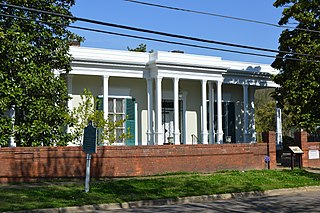
The Veranda House, also known as the Curlee House, is a historic house in Corinth, Mississippi, U.S..

The Dr. John Owen Campbell House is a historic house in Lebanon, Tennessee, United States. It was built from 1841 to 1843 for B. W. G. Winford. It was designed in the Greek Revival architectural style. It remained in the Winford family until 1906, when Winford's son-in-law, B. F. Lester, sold it to Dr. John Owen Campbell, the son of Tennessee Governor William Bowen Campbell. It was later acquired by Herbert C. Ruck. It has been listed on the National Register of Historic Places since December 8, 1980.
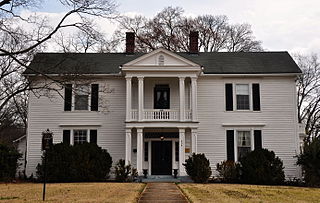
The Frierson-Coble House is a historic house in Shelbyville, Tennessee, U.S.. It was built in 1835 for Erwin J. Frierson, who was trained as a lawyer by James K. Polk, who went on to serve as the 11th President of the United States from 1845 to 1849. Frierson served as a member of the Tennessee House of Representatives in 1845. In 1888, the house was purchased by Dr Neely Coble, a physician; it was later inherited by his son, Thomas Coble, also a physician. By the 1980s, it still belonged to the Coble family. It has been listed on the National Register of Historic Places since April 12, 1982.






















